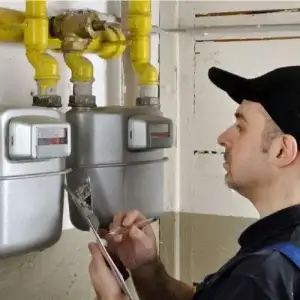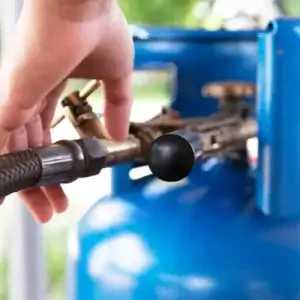Home / Compare Electricity & Ga… / Types of gas

Key takeaways
Many Australian households rely on gas to heat their water and power their appliances. Our guide will take you through the two types of gas and whether one may be suitable for your household.
- If you want to use power appliances with gas, you will either need to be connected to the gas mains pipeline (for natural gas) or purchase liquid petroleum gas (LPG) cylinders to connect to your appliances.
- LPG and natural gas are not interchangeable, and you will need to have your appliances professionally refitted for this change to occur.
- You cannot solely power your home with gas. Even if you power part of your home with gas, you will still receive electricity bills.
- Compare the Market only offers comparison for natural gas, as LPG does not require a household to have a gas plan.
What are the types of gas available to households?
Despite the push towards renewable energy, gas is still in high demand. There are two types of gas supplied to Australians depending on where they live: reticulated natural gas and liquified petroleum gas (LPG).
Reticulated natural gas, also known as natural gas, is distributed by pipeline. Natural gas is primarily made up of gaseous methane, which is collected during the fossil fuel burning process by drilling through gas wells. This type of gas is a low-carbon fossil fuel.
LPG, on the other hand, is a mixture of primarily liquefied propane and butane gases. This type of gas is also a low-carbon fossil fuel; however, it’s obtained through crude oil refinement.
Expert tips on understanding your natural gas plan
If you currently receive a gas bill from an energy retailer, are looking to switch retailers, or are moving to a new property with a gas connection, our Head of Energy, Meredith O’Brien, has some top tips for managing your gas plan.

Review your current offer
If you have reticulated natural gas, review your current plan to see if you’re paying the lowest gas price. If you haven’t reviewed your plan in more than a year, there’s a good chance you could save by comparing your options.
Switch without disruptions
If you are switching to a new gas retailer, you do not pay a connection fee and there is no disruption to your supply. Keep in mind, switching gas providers can still take up to 90 days.
Turn off your gas hot water system and save
If you’re going on holiday for a week or more, turning your hot water system to holiday mode (or off it’s an older system) can help reduce your gas bill. Another way to save is to turn off your hot water until 45 minutes before showering or bathing – just make sure you remember to turn it back on!
Reticulated natural gas explained
Can I get natural gas at my house?

A network of pipelines distributes reticulated natural gas in certain parts of Australia. To be eligible for reticulated natural gas, you must live near a gas transmission pipeline so that a gas fitter can connect your home to a gas supply.
If there isn’t an existing pipeline that the gas fitter can connect you to, they may be able to arrange a new connection and meter box for you. However, this will typically come at an extra cost.
This type of gas is supplied and charged similarly to electricity. You receive a steady stream of gas, and it’s generally billed bi-monthly in Victoria or quarterly in all other states. To find out more about gas charges and bills, read our article on how to read energy bills.
Advantages of reticulated natural gas
Reticulated natural gas is a cleaner alternative for those wanting to reduce their carbon footprint. It’s mainly made up of methane, which is produced through fossil fuel combustion. However, it combusts the least amount of carbon dioxide compared to other types of fossil fuels.1
Gas is generally cheaper than electricity and can help you save through various appliances, including:
- Gas ranges and ovens
- Water heaters
- Slab or underfloor heating
- Gas heaters and fireplaces
- Clothes dryers
- Furnaces
- Outdoor lighting and heating
Disadvantages of reticulated natural gas
If you’re not already connected to a pipeline, the initial connection fees can be an expensive up-front cost. In addition, if you don’t already have gas appliances, you’ll have to get new ones.
If your appliance runs on reticulated natural gas, the gas fitter can adjust it to use LPG on the spot. Keep in mind that only a licensed gas fitter can do this, and you should not attempt to do this yourself. Also, if your household has a high gas usage, you may find switching to LPG can actually increase your gas costs compared to using natural gas.
You can’t run a house entirely on gas, though, so you’ll still have two separate bills for electricity and gas. Even a gas range uses some electricity.
What if I don’t have a natural gas connection?
Not everyone is eligible for reticulated natural gas, as transmission pipelines have limited reach. If you can’t be connected to the pipeline for reticulated natural gas, you will have to get LPG delivered by bottle.
Liquified petroleum gas (LPG) explained
How does LPG work?

LPG is a mixture of gases (mainly propane and butane) that’s typically used for heating, cooking and hot water. It’s stored in 45kg or 90kg refillable cylinders and delivered to your home. When you run out, you’ll have to call your supplier to have a licensed gas fitter deliver new bottles. The 45kg bottles can be replaced as needed, while 90kg bottles need to be accessible from the street for refilling.
Most gas fitters will install two bottles at a time. You can choose to install one, but you’ll have to frequently check your usage to make sure you don’t run out before the new bottle arrives.
Advantages of LPG
This type of gas ensures that you can have a steady gas supply even if you’re nowhere near a transmission pipeline. The installation is easy, and you only have to buy bottles when you need them; if you only use four bottles a year, for example, you only need to pay twice a year.
Disadvantages of LPG
Unlike reticulated natural gas, you have to stay on top of how much gas you’re using so that you know when to order new bottles. If you forget to order on time, you run the risk of not being able to cook with your gas range or have hot showers for a few days.
Important to know
Which type of gas is best for you?
The best type of gas for you will depend on your location and whether you’re already connected to a pipeline. Consider your situation:
- If you aren’t connected to a pipeline or able to get connected, your only option will be to get LPG if you have gas-fuelled appliances.
- If your home is already connected to a pipeline, you’ll have the option to get either reticulated natural gas or install facilities to accept LPG. However, keep in mind that you’ll have to continuously monitor and order bottles for a steady gas supply with LPG.
- If your home isn’t connected to a pipeline, but is able to get connected, it’s wise to consider the upfront costs of getting connected and your household’s energy consumption. If your household has a high energy consumption, you’ll likely be ordering LPG bottles frequently, so natural gas may be more convenient. If you can’t afford the upfront costs of connecting to a pipeline or have a low energy consumption, you may want to consider LPG.
Which energy retailers provide natural gas?
The natural gas providers available to you will depend on where you live. Our energy comparison service can help those in Western Australia, south-east Queensland, South Australia, New South Wales, Victoria and the ACT compare gas plans to find one suitable to your energy needs.
Unfortunately, we can’t yet help residents in Tasmania and the Northern Territory with gas. Residents in these areas can contact their local distributor about getting connected to gas.
Can I connect natural gas appliances directly to a cylinder?
If you have natural gas appliances, they can be converted to LPG by a licensed professional. LPG bottles can be dangerous to use on a natural gas appliance because they’re sealed under high pressure, so you should rely on a licensed gas fitter rather than attempting it convert it yourself.
Do I have to get new appliances if I switch to gas?
If you have electric appliances that you want to fuel with gas, you’ll have to buy new gas-compatible appliances. LPG and reticulated gas can run on the same appliances after a gas fitter adjusts it.
Meet our energy expert, Meredith O’Brien
As the Head of Energy at Compare the Market, Meredith O’Brien believes in educating Australian customers about the everchanging gas and electricity market so they can adjust their energy usage habits and get the most out of their energy plans.
Meredith has six years within the energy industry, following 15 years of experience in financial services and is currently studying a Master of Business Administration. Meredith is a dedicated customer advocate who is passionate about empowering Australians to find the right products to suit their needs by removing the confusion from comparing.
1 Australian Parliament House. Australian electricity options: natural gas. Published July 2020. Accessed October 2023.


